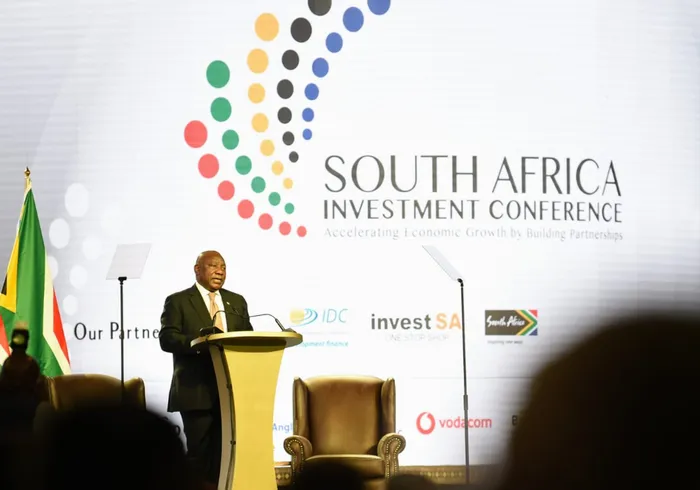Jury out on success of president’s investment drive

Picture: President Cyril Ramaphosa addresses delegates at the 4th South Africa Investment Conference in Sandton Picture: GCIS
By Prof Bonke Dumisa
When President Cyril Ramaphosa assumed office as the president of South Africa in 2018, one of the areas he prioritised for his flagship projects were to launch the South African Investment Conference for South African investors as well as global investors to meet annually and make pledges on how much they commit themselves to invest in the South African economy.
So enthusiastic were the organisers of the investment conference that they set an ambitious investment drive to attract at least R1.2 trillion over five years.
Little did they know at that time that the whole world was going to be plunged into at least almost two years of economic disruptions and lockdowns due to the Covid-19 pandemic.
On Thursday, the 5th South African Investment Conference is due to be held at the Sandton Convention Centre. It will mark the final leg of the R1.2 trillion investment drive.
The good news is that, despite the two years of Covid-19 business disruptions and lockdowns, the investment initiative has raised at least R1.14 trillion since 2018, which represents a 95% success rate on the R1.2 trillion investment target. Last year, when the country was barely out of the Covid-19 pandemic, the 4th investment conference was held where at
least R367 billion in investments were pledged. This means the investment conferences have been able to raise an average of at least R290bn a year since 2018, not including the year(s) when the investment conference was not held due to the stringent Covid-19 pandemic restrictions on meetings.
The year 2023 has a different type of pandemic: Eskom’s load shedding,
which has become so intense in ravaging businesses, especially since last year, is estimated to have cost the South African gross domestic product (GDP) at least 20% a year over the past two years. And it is getting worse by the day.
It is against this background that some sceptics are wondering if this year’s investment conference will yield possible positive results.
My answer is yes, this year’s investment conference will be successful
despite all the prevailing economic gloom and doom being predicted, including the wild speculations that the country might even face the possibility of a total collapse of the Eskom systems.
You must remember that we need only R60bn more in order to achieve the R1.2 trillion investment target.
What is R60bn when we were able to raise at least R367bn last year when we were limping from Covid-19 lockdown conditions?
What is more encouraging about the nature of the South African Investment Conference (SAIC) investment pledges is that it is not necessarily confined to new green-field investments.
It also includes business expansions and other business-growth strategies.
It was in this spirit that in my most recent article on the topic, I wrote about the impressive business expansions of well-established companies like South African Breweries, Toyota South Africa and the Ford Motor Corporation.
While the South African real GDP growth rate is expected to contract even more, by 0.1% in 2023, mainly due to Eskom’s load shedding, the country’s gross fixed capital formation is predicted at least at R664bn by the end of the first quarter of 2023.
The figures clearly indicate that the economic hard times predicted for this year does not equate to significantly lower investments compared to sizeable investments achieved in previous years under severe Covid-19 pandemic business conditions.
Most businesses usually choose periods of economic downturn to repurpose and reposition themselves. The many tax-deductible incentives offered by the government, as announced in the annual Budget Speech 2023, will encourage most businesses to partially move to less Eskom power reliance, and move to more alternative energy sources.
This becomes a good opportunity for global and domestic investors to invest more in this area. For example, the Western Cape provincial government has announced that it would be significantly moving away from its reliance on the Eskom grid, specifically to cut down on incidents of load shedding. This presents an excellent investment opportunity for global and domestic investors who are not wary of public-private business partnerships.
Some of the economic sectors that previously significantly benefited from such SAIC pledges include mining, manufacturing, agriculture and the digital economy.
The damage to the South African economy and the significant increase in the unemployment rates create an opportunity for smart investors to see how they can strategically introduce import-substitution investments that will not be prone to our sometimes hostile and less productive industrial labour relations, which are part of the reasons why many South African manufactured products have been mostly replaced by imported substitutes. Expect far more than R60bn in bankable investments pledges at the SAIC on Thursday.
Prof. Bonke Dumisa is an independent economic analyst
Related Topics: